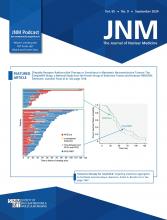TO THE EDITOR: We read with interest the article “The Diagnostic Value of the Sentinel Node Procedure to Detect Occult Lymph Node Metastases in PSMA PET/CT Node–Negative Prostate Cancer Patients” published by Duin et al. (1). We acknowledge that this multidisciplinary team has good expertise in the field of sentinel lymph nodes (SLNs) in prostate cancer, so we would like to provide a few comments.
First, the results reported are nothing new since evidence of the feasibility of SLN biopsies has been shown for many years (2), but we must admit that this technique has trouble finding its way to routine use. How could the authors explain such reluctance to routinely perform SLN biopsies in cases of prostate cancer?
Second, the comparison with negative findings in prostate-specific membrane antigen (PSMA) PET/CT is not that easy given the variable performance reported in the literature. Corfield et al. reported a sensitivity of detecting metastases in 68Ga-PSMA-11 PET/CT ranging from 33% to 99% (3). Moreover, interpreting negative results is challenging. In their paper, Duin et al. reported macrometastases (with PSMA expression immunohistochemically) in 36% of their patients with negative PET/CT results, whereas Klingenberg et al. showed that pathologic nodes were missed in PET/CT in the cases of either micrometastases or metastases without PSMA expression (4).
Third, the authors suggest performing SLN biopsies in patients with negative PSMA PET/CT findings, which could appear conflicting with the findings reported by Kopp et al., highlighting the reliable negative predictive value compared with the poor positive predictive value (5,6). Should SLN biopsies then be performed in cases of positive PSMA PET/CT instead?
Fourth, we agree that SLN findings could modify the treatment choice. However, in the case of pathologic involvement, there is an upstaging that may lead to treatment escalation without evidence of benefits in oncologic outcomes. Besides, with negative findings, would it be safe to deescalate treatment even if the risk of nodal involvement is estimated to be high according to nomograms? As a matter of fact, Hötker et al. reported that Briganti 2019 nomogram performed better than 68Ga-PSMA-11 PET/CT and multiparametric MRI to predict nodal metastases (7).
Lastly, the authors did not document SLNs in difficult-to-reach anatomic locations. But we strongly believe that such uncommon lymphatic drainage could explain some patterns of relapse (8), and the SLN technique thus appears to be relevant to enable an individualized and tailored treatment (9).
We are enthusiastic to see a multidisciplinary team emphasizing the benefits in using SLN testing for the staging of prostate cancer. Here, we emphasize some unanswered problems that would need to be addressed before implementing such a technique in our daily practice.
DISCLOSURE
No potential conflict of interest relevant to this article was reported.
Loic Ah-Thiane*, Ludovic Ferrer, Stéphane Supiot, Caroline Rousseau
*ICO René Gauducheau St-Herblain, France
E-mail: loic.ah-thiane{at}ico.unicancer.fr
Footnotes
Published online Jul. 25, 2024.
- © 2024 by the Society of Nuclear Medicine and Molecular Imaging.
REFERENCES
- Received for publication January 18, 2024.
- Accepted for publication February 16, 2024.







